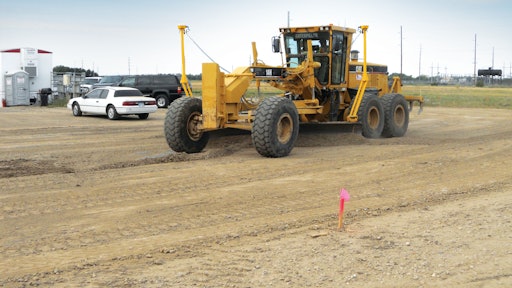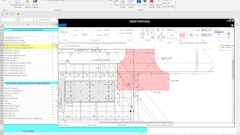
Siemens wind turbines weigh more than 88,000 lbs. each, so subgrade quality was the most important element in successfully completing the company's 277,000-sq.-ft. plant for assembling them near Hutchinson, Kan. The site-prep subcontractor, Wichita's Bob Bergkamp Construction was able to step into the lead role in meeting the project's quality standard by creating a three-dimensional model of the site and employing automatic grade controls to deliver consistent grades.
The design-build general contract went to Gray Construction, and Bergkamp's site subcontract included constructing the building pad and 1.2 million square feet that included a large outdoor lot for inventory, the employee parking lot, three retention ponds and service roads.
"This is a design-build project so we needed to quickly adapt as changes were made as the project evolved," says Justin Howard, field engineer with Bergkamp.
3D model proves popular
Bergkamp's ability to achieve the fine grade necessary for the project depended on using the 3D digital site model the subcontractor built for the project.
"I took the provided plan (from the project's civil engineer) and built a complete digital model using Trimble software that we used to guide our motor grader to achieve consistent grade throughout the project," Howard says.
"Every subcontractor on site that had anything to do with layout, dirt, concrete or asphalt -- even the surveyors and Gray Construction -- were using my information; my model, which is actually a first," says Howard. "I've never been this in-depth with a project."
Howard used several software programs to add layers to Trimble's core software.
Smooth, stable base required
The building's production floor and holding-area lot had to be constructed to withstand the 88-ton load of each wind-turbine nacelle -- more when the enclosures are completed with the wind mill's drivetrain, gearbox and generator.
"The amount of concrete will exceed one million square feet, so we need to make certain the grade is accurate," Howard says. "The plan called for a 12-in. base of fly ash, so you can see this is designed for extreme weight."
The Siemens site is located on former farmland that the city of Hutchinson is developing into an industrial park. Bergkamp's work started with roughing out the building pad's footprint with a pair of scrapers. They applied the finish grade using a motor grader equipped with Trimble GCS900 Grade Control and dual GPS. The GCS900 brought the site plan -- design surfaces, grades and alignments -- into the grader's cab and helped the operator achieve the required plus-or-minus 1/10th-in. accuracy.
Bergkamp mixed and placed the fly ash to stabilize the sandy loam, which set up dense and hard like concrete. The modified subbase had to pass certain moisture and density proctors before an 11-in. lift of concrete would be placed. The fly ash treatment is solid enought that there is no need for crushed aggregate.
Grading for the nacelle inventory/holding lot was critical. "Tolerances for our dirt work were 1/4 inch, which is usually, as you know, a paver's tolerance," says Howard. "The concrete company had originally selected a different dirt contractor, but they were so impressed with the quality of our results from the Trimble dual GPS system on a couple of side spots we did for them that they switched to us for everything.
"Our local Trimble dealer came out to the site and helped us tighten the measurements we were achieving with the blade," Howard adds. "We made quite a few test passes and made sure that it was matching the [SPS881] rover within a couple hundredths. Actually, most of the time it was less. We essentially fine tuned the grader to the site. Everybody was quite impressed with it, especially Gray Construction."
Considering the loads the pavement would be subjected to, precision in the subgrade was critical.
"If there were soft spots in the subgrade, that 11 ins. of concrete would to start to crack and crumble and tear apart," says Howard. "It could create future maintenance costs. That's why our grading had to pass so many tests; density tests, moisture tests and others."
The project was completed ahead of schedule.
"There were a lot of changes on this project, but that's the nature of design-build sites," says Howard. "We've invested a lot of sweat and time, but with the help of Trimble technology we were able to save production time and achieve the results we wanted.
"We became the 'go-to' source for answering questions and preventing problems because of the quality of the 3D model we built and the tight finish grade we achieved on all three areas of the site."





























